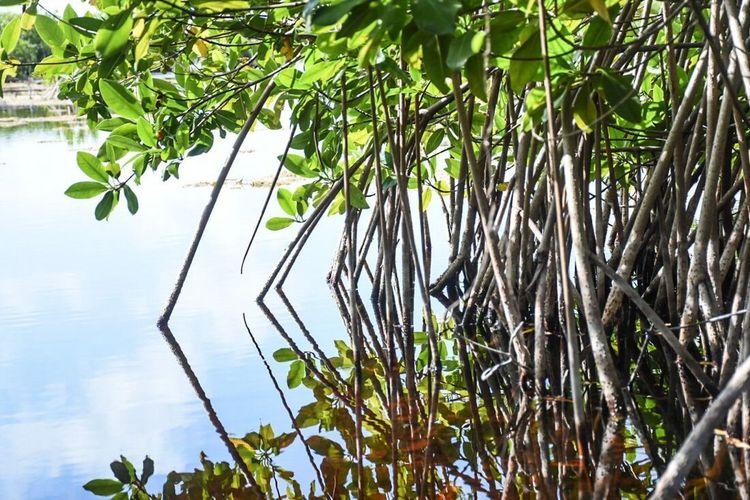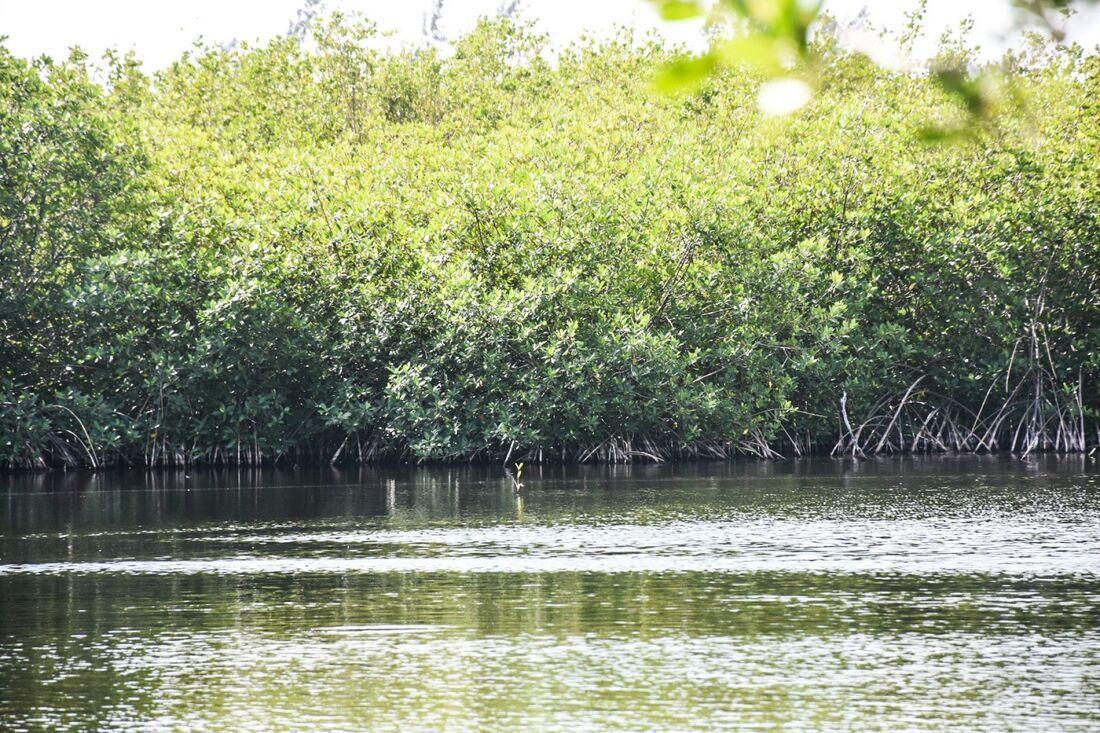Until a few decades ago, mangrove research had no priority among the scientific community. These ecosystems, which have been converted into urban developments or shrimp ports, predominate on the tropical coasts that go from Florida, the United States, to Brazil, and provide oxygen and protect against hurricanes.
Researcher Rafael J. Araujo began to be interested in these ecosystems since he was a student. After finishing his degree as a marine biologist in Bogotá, he decided to contact Samuel Snedaker, a researcher linked to the University of Miami, considered one of the founders of mangrove ecology.
“I contacted him and told him that I was interested in being his student. He welcomed me into his laboratory and was my mentor,” recalls the Colombian researcher, who is currently part of the Department of Marine Biology and Ecology at the University of Miami.
Araujo focused on the architecture of mangrove forests. This was and has been his main line of research: structural aspects. But he has also worked on the link between mangroves and coral communities.
In 2022, the research took a step further when a group of researchers from the University of Miami, Santa Fe College and the University of Florida, including Rafael J. Araujo, developed a system that identified how corals, which are characteristic of the seas, migrate to mangroves as a refuge. This is relevant to the threats faced by reefs due to pollution, overfishing and destruction by human activity.

Mangroves in Quintana Roo, Mexico. Photo: Elizabeth Ruiz/cuartoscuro.com
— How did this line of work on mangroves and corals come about?
One of my parallel lines of work is the importance of mangroves for fish, especially reef fish. From this, the interest in making a link between mangroves and the coral communities that grow inside was born.
This had not been extensively reported before for many reasons, perhaps we were not seeing or were not recognizing this association. And although it was always known that there were small coral communities in mangroves, what we are reporting is a system in which corals use mangroves as shelter against conditions that are extreme.
For example, given the high temperatures in the reef, mangrove areas offer shade, a lower temperature and other types of physico-chemical conditions that allow them to migrate from the reef to the mangrove, as in Boca del Toro, Panama, which we found to be 20 meters inside, which is quite a lot.
We have been trying to describe why these communities are independent, they should be considered independent and, in addition, there is variety, they are not homogeneous, but there are different types of associations between corals and mangroves.
— And when they did this classification system, what was the process to identify this relationship?
When we decided to do the classification system, the first thing was to look for this type of association in the (scientific) literature. We found that there were reports that dated back to the 1950s, so once these documents were accumulated, we could see what was being described and what it had in common with what we were seeing in Panama.
Thus, we built a model in which we were able to use geographical information systems to feed with certain parameters, for example, tide, presence or absence of mangroves, presence or absence of corals, and to be able to predict the potential locations of this type of ecosystem.
The intention is that more and more researchers, when they find these areas, can report them and this will help to create a database that is increasingly robust and will make it easier for us to better understand the conditions that promote this association.
— Once these first results have been obtained, what makes it possible to understand that there is this relationship between mangroves and corals?
More immediately, what classification allows us is to understand that there is a much more dynamic connection between corals and mangroves than we knew before.
The classic system describes tropical coastal areas where there is a strip of mangrove forest that can be small or very large, then it is usually associated with seagrass and then there is a coral reef. And there is always a connection between these three ecosystems.
But what we haven't identified before is that corals are possibly now migrating to mangrove areas where the physical and chemical conditions are not as extreme as on the reef. So if there is temperature stress on the reef, some of these communities will be able to survive as refugees in the mangrove where the temperature is lower because they are under the cover of the forest canopy.
What we want to understand is what are the dynamics that favor this coral establishment within the mangrove forest and the immediate management applications. For example, it gives us more impetus to protect mangroves since they can be like a previously unidentified coral reserve. Many of these species may exist in the future associated with mangroves since life on the reef is very stressful.
— In addition to science, how could these findings be transferred to other aspects such as decision-making from the political or social spheres?
This question is incredible because that is really the objective of those of us who work in management: to see how to transfer this to something more real that naturally protects the ecosystem.
In an immediate way, what this does is it increases the importance of these coastal ecosystems because we already know, for example, that conserving mangroves is much cheaper than removing them and then providing the same services. The mangrove protects against erosion, it protects against storms and this can be measured and transferred at an economic cost and that economic cost naturally has an important political value because if there is no mangrove forest, we are going to have to build a wall and this wall will be much more expensive than natural protection.
The other is that there are new economic mechanisms that are emerging based on blue carbon economies. Then countries like Mexico that have extensive mangrove areas, some of the largest in the Americas, will be able to monetize this mangrove protection at a governmental level and could use these carbon credits to meet the promises they have made in international forums regarding their commitments to mitigate climate change.
— From your perspective as a Colombian researcher working at the University of Miami, how do you perceive the opportunities for the scientific community in other Latin American countries regarding mangroves?
I think that globally, Latin America has always been at the forefront of what is happening with regard to mangrove forests. Perhaps because there is less money or for any other social or economic reason, alternatives are always being sought that are different from those promoted by nations such as the United States.
In terms of protection, there is still a long way to go and Mexico is a good case study because there have been cycles in which mangroves are protected, then the protection is removed or it is a little weak, then the protection returns... but there is always environmental awareness and that is persistent in Latin America. People have a more sophisticated awareness of the environment, perhaps because of the closer connections they have historically had with ecosystems.
This for me is a cause for optimism because I see that countries such as Mexico, Colombia and Brazil are exploring different and unique mechanisms and in which they seek to include the voice of local communities, what is important for them and how they can play a more participatory role in the management of mangroves.
Latin America, and Asia as well, have always played an important role in pushing for the local community to be part of the decision and that its values, its history, are part of the way in which we manage the mangrove. This seems to me to be Latin America's most important contribution to the conversation about how to manage mangroves at a local level.
— And after the classification, what's next with regard to your lines of work?
The classification is a call to the scientific community to help us and begin to see that this could be happening in their workplaces, but that no one has ever seen them, reported them or does not think they are important. So this (research) never ends, as any scientific exercise always grows, grows and grows with the additional contribution.
Another thing I'm working on now is education, but not higher education, but I'm developing with the School of Music, the School of Engineering and the School of Education of the University of Miami a simulation using virtual reality called “The Mangrove City”. And we are going to distribute this free of charge and translated into more than 40 languages so that children between 10 and 14 years old anywhere in the world can use this virtual reality game to understand why mangroves are important, what is the future of mangroves and how they can participate in this future.
Finally, these are the people who are going to inherit the broken world that we left them and it is important that long before they begin to see the importance of these ecosystems and how to be part of them and of the solution. It's something that makes me very happy because reaching this young audience is something I never thought about before.



Comentarios (0)